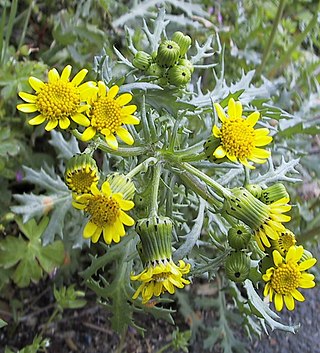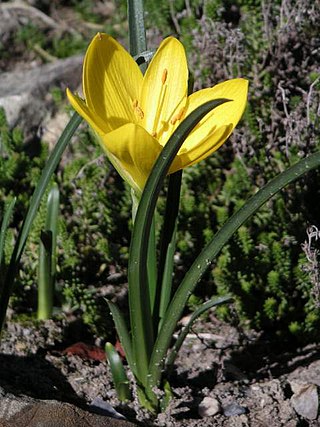
Senecio is a genus of flowering plants in the daisy family (Asteraceae) that includes ragworts and groundsels.

Senecio vulgaris, often known by the common names groundsel and old-man-in-the-spring, is a flowering plant in the family Asteraceae. It is an annual herb, native to the Palaearctic and widely naturalised as a ruderal species in suitable disturbed habitats worldwide.
Backcrossing is a crossing of a hybrid with one of its parents or an individual genetically similar to its parent, to achieve offspring with a genetic identity closer to that of the parent. It is used in horticulture, animal breeding, and production of gene knockout organisms.

Senecio cambrensis is a flowering plant of the family Asteraceae. It is endemic to Great Britain and currently known only from North Wales. It is a recently evolved plant that arose as a result of hybridization between two related species.

Senecio ampullaceus, also known as Texas ragwort, Texas squaw-weed, Texas groundsel, and Texas butterweed, is a species of Senecio in the family Asteraceae, receiving its Latin name ampullaceus from its flask shaped flower-head. It is recommended for landscape use in its native Texas.

Senecio squalidus, known as Oxford ragwort, is a flowering plant in the daisy family Asteraceae. It is a yellow-flowered herbaceous plant, native to mountainous, rocky or volcanic areas, that has managed to find other homes on man-made and natural piles of rocks, war-ruined neighborhoods and dry-stone walls. These habitats resemble its well drained natural rocky homeland. The plants have spread via the wind, rail and the activities of botanists. The travels of this short-lived perennial, biennial, or winter annual make it a good subject for studies of the evolution and ecology of flowering plants.

Senecio eboracensis, the York groundsel or York radiate groundsel, is a flowering plant in the daisy family Asteraceae. It is a hybrid between a native and a non-native introduced species, which naturalised in England but the population failed to sustain itself. It was brought back by captive cultivation. It is a self-pollinating hybrid species of ragwort and one of only six new plant species to be discovered in either the United Kingdom or North America in the last 100 years.

Senecio gallicus, an annual plant of the genus Senecio and family Asteraceae, is a species that colonizes isolated habitats with difficult environmental conditions. It is widespread across southern France and the Iberian Peninsula in deserts and xeric shrublands, on steppes and salty dry coastal plains. S. gallicus is playing a predominant role in shaping patterns of genetic structure by presenting models of historical associations among population rather than patterns of ongoing gene flow.

Sternbergia is a genus of Eurasian and North African plants in the Amaryllis family, subfamily Amaryllidoideae.

Senecio angulatus, also known as creeping groundsel and Cape ivy, is a succulent flowering plant in the family Asteraceae that is native to South Africa. Cape ivy is a scrambling herb that can become an aggressive weed once established, making it an invasive species. It is grown as an ornamental plant for its satiny foliage and sweet-scented flowers.

Senecio leucanthemifolius is a plant common in sea-side in Mediterranean area.

Senecio glaucus is an annual member of the Asteraceae and species of the genus Senecio. It is found from the western Mediterranean to Central Asia in sandy, well-drained soil, particularly coastal and desert dunes.

Dendrosenecio kilimanjari is a giant groundsel found on Mount Kilimanjaro in Africa, below 4,000 metres (13,000 ft).
Dendrosenecio brassiciformis is a species of East African giant groundsel. It is endemic to the slopes of Aberdare Range and bearing fruit but once, and dying after. Once considered to be of the genus Senecio but since have been reclassified into their own genus Dendrosenecio.

Roldana petasitis, also known as the velvet groundsel or Californian geranium, is a species of the genus Roldana and family Asteraceae that used to be classified in the genus Senecio. It is native to Central America.

Senecio fremontii, the dwarf mountain ragwort, is a species of the family Asteraceae. It takes its scientific name from John C. Frémont.

Senecio triangularis, known as arrowleaf ragwort, arrowleaf groundsel and arrowleaf butterweed, is a species of the genus Senecio and family Asteraceae.

Sandy iris, or sand iris, is a species in the genus Iris; it is also in the subgenus of Iris and in the Psammiris section. It is a rhizomatous perennial, from Central Europe, found in Hungary, Austria, Romania, Czech Republic and Ukraine. It has grass-like leaves, a short stem and pale yellow flowers. It has had a mixed origin and was once Iris humilis subsp. arenaria, a subspecies of Iris humilis, until it was reclassified as a separate species. But many sources still state that it is either a synonym or subspecies of Iris humilis. It is cultivated as an ornamental plant in temperate regions.

Dianthus petraeus, the rock pink or fragrant snowflake garden pink, is a species of Dianthus native to Romania, the former Yugoslavia, Albania, and Bulgaria. It is often found growing on calcareous rocky slopes, or in dry highland forest edges. It is occasionally grown in rock gardens.

Scabiosa columbaria, called the small scabious or dwarf pincushion flower, is a widespread species of flowering plant in the genus Scabiosa, native to Europe, Africa, and western Asia, from Sweden to Angola. In the garden it is a short-lived deciduous perennial. In the wild in Europe it prefers to grow in calcareous grasslands.




















